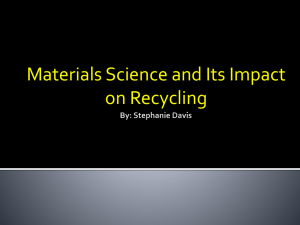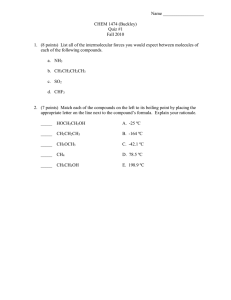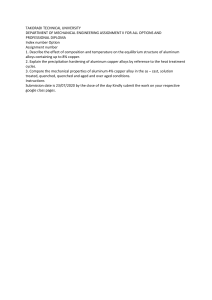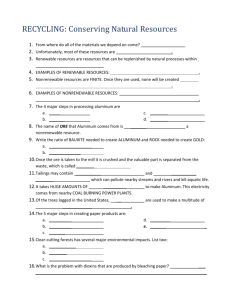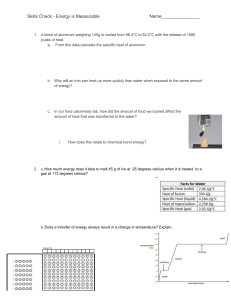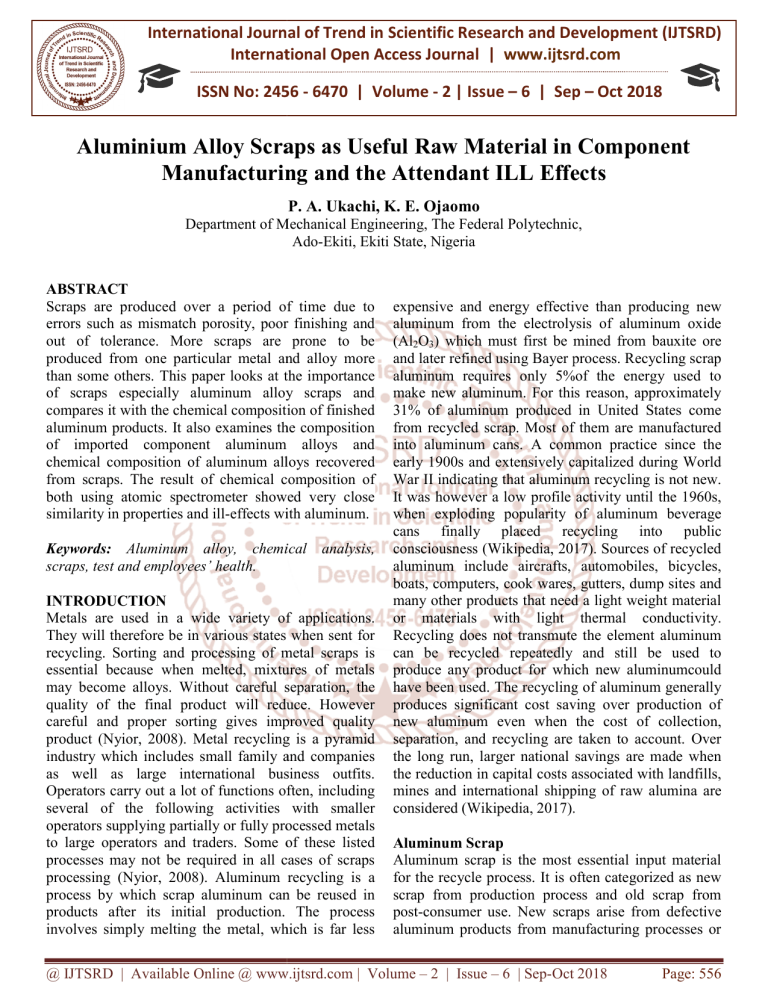
International Journal of Trend in Scientific Research and Development (IJTSRD)
International Open Access Journal | www.ijtsrd.com
ISSN No: 2456 - 6470 | Volume - 2 | Issue – 6 | Sep – Oct 2018
Aluminium Alloy Scraps aas Useful
seful Raw Material in Component
Manufacturing and tthe
he Attendant ILL Effects
P. A. Ukachi, K. E. Ojaomo
Department of Mechanical Engineering, The Federal Polytechnic,
Ado-Ekiti, Ekiti State, Nigeria
ABSTRACT
Scraps are produced over a period of time due to
errors such as mismatch porosity, poor finishing and
out of tolerance. More scraps are prone to be
produced from one particular metal and alloy more
than some others. This
his paper looks at the importance
of scraps especially aluminum alloy scraps and
compares it with the chemical composition of finished
aluminum products. It also examines the composition
of imported component aluminum alloys and
chemical composition of aluminum
minum alloys recovered
from scraps. The result of chemical composition of
both using atomic spectrometer showed very close
similarity in properties and ill-effects
effects with aluminum.
Keywords: Aluminum alloy, chemical
scraps, test and employees’ health.
analysis,
INTRODUCTION
Metals are used in a wide variety of applications.
They will therefore be in various states when sent for
recycling. Sorting and processing of metal scraps is
essential because when melted, mixtures of metals
may become alloys. Without careful separation, the
quality of the final product will reduce. However
careful and proper sorting gives improved quality
product (Nyior, 2008). Metal recycling is a pyramid
industry which includes small family and companies
as well as large international business outfits.
Operators carry out a lot of functions often, including
several of the following activities with smaller
operators supplying
ying partially or fully processed metals
to large operators and traders. Some of these listed
processes may not be required in all cases of scraps
processing (Nyior, 2008). Aluminum recycling is a
process by which scrap aluminum can be reused in
products after
fter its initial production. The process
involves simply melting the metal, which is far less
expensive and energy effective than producing new
aluminum from the electrolysis of aluminum oxide
(Al2O3) which must first be mined from bauxite ore
and laterr refined using Bayer process. Recycling scrap
aluminum requires only 5%of the energy used to
make new aluminum. For this reason, approximately
31% of aluminum produced in United States come
from recycled scrap. Most of them are manufactured
into aluminum cans. A common practice since the
early 1900s and extensively capitalized during World
War II indicating that aluminum recycling is not new.
It was however a low profile activity until the 1960s,
when exploding popularity of aluminum beverage
cans finally placed recycling into public
consciousness (Wikipedia, 2017). Sources of recycled
aluminum include aircrafts, automobiles, bicycles,
boats, computers, cook wares, gutters, dump sites and
many other products that need a light weight material
or materials with
th light thermal conductivity.
Recycling does not transmute the element aluminum
can be recycled repeatedly and still be used to
produce any product for which new aluminumcould
have been used. The recycling of aluminum generally
produces significant cost saving
aving over production of
new aluminum even when the cost of collection,
separation, and recycling are taken to account. Over
the long run, larger national savings are made when
the reduction in capital costs associated with landfills,
mines and international
al shipping of raw alumina are
considered (Wikipedia, 2017).
Aluminum Scrap
Aluminum scrap is the most essential input material
for the recycle process. It is often categorized as new
scrap from production process and old scrap from
post-consumer use. New scraps arise from defective
aluminum products from manufacturing processes or
@ IJTSRD | Available Online @ www.ijtsrd.com | Volume – 2 | Issue – 6 | Sep-Oct
Oct 2018
Page: 556
International Journal of Trend in Scientific Research and Development (IJTSRD) ISSN: 2456-6470
2456
of semi-fabricated
fabricated final products whereas old scraps
refer to those products collected after being used and
disposed by consumers. Old scrap is often more
contaminated and tedious
us to reuse than new scrap.
End of life vehicles, demolished buildings and
constructions, discarded packaging materials, home
and office appliances as well as machine equipment
are all potential sources of old aluminum scraps
(Aluminum, 2018). There is abundant
ndant metal scraps in
Nigeria especially aluminum scraps which should be
serving as useful raw material for our foundry
industries especially now that the economy needs
diversification. The abundant metal scraps in our
country are presently exported. There were illegal
attempts in September, 2011 to export four container
loads of aluminum scrap valued at over
US$470000(Recycle international, 2011). These are
raw materials that can be utilized in our
manufacturing industries. Aluminum is one of the
only materials
rials in the consumer and industrial waste
stream that pays for its recycling. This recycling
process propels business activity rapidly. (Ukachi,
2016)
Sorting of Aluminum Scraps
The collection and sorting of aluminum scraps
especially old scraps is often a complex scheme
involving millions of households, local and regional
authorities, small and medium collectors and metal
merchants. Waste and environmental policies can also
have strong influence on the collection schemes.
Sorted aluminum scrap may need to be separated
further and pre-treated
treated before the metal can be
recovered in melting furnaces. Separation of
aluminum at this stage can be done by various
mechanical operations, such as magnetic, gravity,
eddy current or colour sensor. Further separation oof
different aluminum alloys can be achieved through xxray methods. Wrought alloys and casting alloys are
often separated before the mechanical processes
where possible (Aluminum, 2018)
Ill - Effects of Aluminum on Humans and
Environmental Problems.
The
advantages
vantages
of
aluminum
recycling
notwithstanding, there are human and environmental
problems. Recycling aluminum requires only five
percent of the energy required to manufacture new
aluminum from bauxite. However, recycling
aluminum produces many toxic chemi
chemicals that
released into the air. Furthermore recycling aluminum
produces a waste called “dross” that is highly toxic to
be buried in landfills. This dross must be tightly
sealed in containers so that it doesn’t leak out and
enter ground water. In order to recycle aluminum
must be melted to separate the pure metal from the
impurities. This process produces a waste product
known as salt cake. For every ton of aluminum that is
melted 200 to 500 kilograms of salt cake are
produced. It contains aluminum oxides, metallic
aluminum, carbides, nitrides, sulphides and
phosphides. Salt cake is highly toxic to living
organism (David, 2018).
Occupational exposure to aluminum occurs during the
refining of the primary metal and in secondary
industries that use aluminum products.
pr
Several studies
have reported adverse respiratory tract effects in
aluminum
industry
employees.
Asthma-like
Asthma
symptoms, known as pot-room
room asthma have been the
most intensive investigated respiratory effect.
Wheezing, dyspnea and impaired lungs function
functi are
also part of ill effects. Several cross sectional case
control and longitudinal studies have demonstrated
increased frequency of adverse pulmonary effects in
pot-room
room workersas compared to non-exposed
non
workers (Daniel et al, 2018). It is the most widely
wid
distributed metal on the planet and it’s used in the
production of many every- day products. Cookware is
made from aluminum, soda cans are aluminum, and
aluminum foil is found in most kitchens. Aluminum is
also in antacids, aspirin, vaccines, and even flour.
This overwhelming infestation of aluminum means
that your risk of exposure is through the roof, which is
also made of aluminum. Unlike vitamins, minerals,
and trace elements, the body does not need aluminum.
And aluminum is no innocent or benign participant.
par
Aluminum accumulates in the kidneys brain, lungs,
lever and thyroid where it competes with calcium for
absorption and can affect skeletal mineralization. In
infants, this can slow growth. And models have linked
aluminum exposure to mental impairments.
impairm
(Edward,
2016)
Materials and Methods
The essential materials for the study include
aluminum alloy scraps, moulding box (cope and
drag), pattern of aluminum motorcycle clutch handle
and atomic emission spectrometer.
Sand casting method was used to produce
p
aluminum
motorcycle clutch handle following standard
procedures from moulding to casting and finishing.
@ IJTSRD | Available Online @ www.ijtsrd.com | Volume – 2 | Issue – 6 | Sep-Oct
Oct 2018
Page: 557
International Journal of Trend in Scientific Research and Development (IJTSRD) ISSN: 2456-6470
2456
Both the imported and the locally made aluminum
alloys of motorcycle clutch handles were subjected to
chemical analysis using the atomic emission
spectrometer (AES) where the intensity of the of light
emitted from plasma flame sparks at a particular
wavelength signaling the quality and quantity of
elements in each sample.
Results and Discussion
The result of the chemical analysis of the locally an
and
imported aluminium alloy of motorcycle clutch
handle are presented in Tables1 and Table 2. In table
1, Aluminium was found to be 95.41% but 95.04% in
table 2 with a mere 0.387% reduction in aluminium
content. Other constituents of the alloy are found to be
approximately the same as shown in these tables.
Further statistical presentations of the results in
graphs (Figure 3 & Figure 4) and pie charts (Figure 5
& Figure 6)revealed no significant spreading or
dipping in composition of the remaining constituen
constituent
elements. Succinctly, the result showed that there is
not much departure in the major chemical content (Al,
Si, and Fe) of the samples. In Table 1 It is worthy of
note that Si (silica)and Fe (iron) content are the
hardness determinant, environment equall
equally affects
this determinants (Nwoye et al, 2010). It is also
worthy of note that the cast alloys interact with the
sand mould which is rich in silica and iron content,
thereby bringing about the material hardness (Bam et
al, 2015)
Conclusion
Locally produced component from scrap aluminium
alloy of motorcycle clutch handle has almost the same
chemical composition with imported sample of
motorcycle clutch handle. This infers that locally
sourced scraps are good raw materials for
manufacturing aluminium alloy products from
recycling. Metal recycling is a multimillion naira
industry that provides secondary raw materials for the
foundry, metal fabrication and related industries. It is
energy efficient, environmentally friendly and
provides employment opportunities
opport
for many if
properly managed.
Recommendation
From the study it is noted that there is no standard
policy for effective streamlining of the scrap recycling
industry in Nigeria and government is losing out on
the numerous offers in that sector. However, the
Nigeria Metallurgical
llurgical Society (NMS), Nigeria Society
of Engineers (NSE), Manufacturing Association of
Nigeria (MAN) and related institutions should prepare
and push for a policy framework to reposition the
industry by maximally harnessing the potentials and
turn aluminium
nium scraps to wealth and a non-oil
non
revenue
base for the nation. Industries should be encouraged
to source their scraps from registered collectors to
regulate and control the quality and mechanisms of
scrap and to avoid revenue loses and tax evasion.
Cooperative
rative groups should be encouraged to set up
schemes to provide convenient and central store for
collected scraps to avoid littering and environmental
issues.
Table 1: The chemical composition of imported aluminium alloy cast handle
Elements
%
Al
Si
Fe
Cu Mn
95.41 3.2 0.8 0.3
0.2
Mg
Zn Cr
Ni
Ti
0.04 0.1 1.5 0.06 0.08
Sr Zr V Ca Be
-
-
-
-
-
Table 2: The chemical composition of locally produced aluminium alloy cast handle
Elements
%
Al
Si
Fe
Cu Mn
95.04 3.2 0.8 0.3
0.2
Mg
Zn Cr
Ni
Ti
0.04 0.1 1.5 0.06 0.08
Sr Zr V Ca Be
-
-
-
@ IJTSRD | Available Online @ www.ijtsrd.com | Volume – 2 | Issue – 6 | Sep-Oct
Oct 2018
-
-
Page: 558
International Journal of Trend in Scientific Research and Development (IJTSRD) ISSN: 2456-6470
2456
Figure 1: Graphical representation of produced Aluminium alloy composition
Figure 2: Graphical representation of scrap Aluminium alloy composition
Figure 3:: Pie Chart presentation of imported material
@ IJTSRD | Available Online @ www.ijtsrd.com | Volume – 2 | Issue – 6 | Sep-Oct
Oct 2018
Page: 559
International Journal of Trend in Scientific Research and Development (IJTSRD) ISSN: 2456-6470
2456
Figure 4: Pie Chart presentation of imported material
References
1. Aluminum Recycling –Materials
Materials (2016)
“Aluminum
for
Future
Generations”
http://recycling.worldaluminium.org/resources/ma
terials/Retrieved on 1/25/2018,
2. Bam, S. A. Iortsor, A. and Akaaza,
aaza, J.N. (2016).
Improvement and Comparative Analysis of River
Benue Foundry Sand, Using Cassava and Maize
as Binders in casting. International Journal of
Applied Research. Tamil Nahu India (1) 8 pp 712
712714
3. Daniel Krewiski (2018).Human
.Human Health Risk
Assessment for Aluminium Department of
Epidemology and Community Medicine, Faculty
of Medicine, University of Ottawa, Ottawa,
Ontario,
Canada.
pp
7,https://www.ncbi.nlm.nih.gov/pmc/articles/pmc
2782734/. Retrieved on 1/25/2018. 6:34 AM.
4. Nguyen,D.H.(2018) . Environmental Problems
Associated
with
Recycling
Aluminium
File:///c:/users/HP/Downloads/Environmental
Problems Associated with recycling. Retrieved on
8/30/2018, 8:37 pm.
7. Nyior G.B., Dauda G.T. and Muhammed R.A.
(2008).. Metal Recycling, An Under-tapped
Under
Goldmine in the Country. Proceedings of National
Metallurgical Society Conference, held on - pp 87
8. Recycle international
ational (2011). Scrap Export Ban
Arrests
in
Nigeria,
Retrieved
from
http://www.recyclinginternational.com/recyclinghttp://www.recyclinginternational.com/recycling
news/3865/non-ferrous-metals/nigeria
metals/nigeria-india/scrapexport-ban-arrests-nigeria.Retrieved
nigeria.Retrieved
on
02/07/2016.
9. Ukachi P. A., (2016).. Evaluation of the properties
of locally produced aluminum alloy motorcycle
clutch handle. M. ENG. thesis submitted to the
Department of mechanical Engineering, Federal
University of Agriculture, Makurdi. Nigeria.
10. Webster P.D. (1980). Fundamentals of foundry
Technology. Portcullis
tcullis Press Ltd,
Ltd Queensway
House.. Red hill, Surrey. pp 48Wikipedia,(2017).
Aluminum
recycling-Wikipedia.
recycling
https://en.wikipedia.org/wiki/Aluminum
/en.wikipedia.org/wiki/Aluminumrecycling.
Retrived on 1/25/2018, 6:02AM.
5. Global Healing Center (2013), ““Why I’m
Concerned about the Dangers of Aluminum”
http://www.globalhealingcenter.com/natural
://www.globalhealingcenter.com/naturalheath/concerned-about- Retrieved on 2/18/2016
2:53PM.
6. Nwoye, C. I., Obiegwu, E. O. and Mba, C. N.
(2010).. Model of Periodic Assessment and
Prediction of Otamiri Refractory Designated for
Oven Drying Development. Journal
nal of metallurgy
and Materials (JMM) Vol. 5 No. 2, pp 48
48-54
@ IJTSRD | Available Online @ www.ijtsrd.com | Volume – 2 | Issue – 6 | Sep-Oct
Oct 2018
Page: 560




